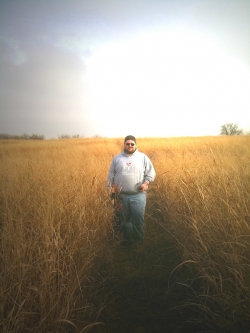Switchgrass Establishment Research Project
In late Spring of 2010, CRAFT Program Director, Dr. Bruce Pratt and CRAFT researcher, Gary Selby, began a research project on Switchgrass Establishment. The project entailed two main focuses:
1. Cultivation and establishment methods for plowed vs. non-tilled ground
2. Variety differences between two types of switchgrass: Kanlow and Alamo
Along with these two main facets, they were also able to determine establishment costs, necessary biomass materials for use in conversion to biofuels, and several other aspects of switchgrass establishment. With the help of CRAFT researcher and Economist, Frank O’Connor, they will also be able to conduct a cost of production analysis. (On the right, you can see Gary Selby standing among the 20 acres of switchgrass located in Winchester, KY in Jan. 2012.)
According to Dr. Bruce Pratt, there are many advantages to researching switchgrass, as opposed to other feed stocks. “One advantage we have with switchgrass is that it is a native grass to Kentucky. It was growing naturally before Europeans ever settled in this region. Switchgrass grows on poor soils. It is deep-rooted, so it helps prevent soil erosion, and it also provides wildlife habitat while growing. There are many reasons why switchgrass is a great choice—we could go on all day,” admitted Dr. Pratt.
A total of 60 acres of land dispersed among three separate locations have been utilized for this project that is now two years in the making. Twenty acres of this 60 are located at EKU’s Meadowbrook Farm, 20 acres are in Winchester, KY, and 20 acres are on a piece of land beside Patty A. Clay Hospital in Richmond, KY.
At the Meadowbrook Farm location, switchgrass was planted in Spring 2010, with two sections representing either plowed land or un-tilled (un-plowed) land. They hope to learn which method (plowed or un-tilled) will cede the highest yield of biomass for use in conversion to biofuels. Also planted in Spring 2010 was switchgrass at their allotted location in Winchester, KY, and beside Patty A. Clay Hospital. In both of these locations, they will determine which type of switchgrass (Kanlow or Alamo) is better suited for the area in which it is planted.
“CRAFT’s switchgrass research plots are designed to provide us with information for the best variety, the best field type (old corn ground vs. old hay ground vs. native pasture), and the best tillage practice,” says Researcher, Gary Selby, “to arrive at the optimum combination of variables for switchgrass production in central Kentucky.”
Depending on weather and several other factors, they hope to harvest all three locations of planted switchgrass in February 2012. With the harvesting, they will focus on the main purposes of this project, but will also be able to compare different methods of storage. “This study will also give us information about the production potential for switchgrass, which can then be converted to cost of producing a kilogram of sugar from switchgrass,” stated Selby.
The estimated cost of establishment is about $45 per ton in Central KY, at the average yield of six tons of switchgrass per acre.
Contact Information
Bruce Pratt
Bruce.Pratt@eku.edu
859-622-7316
Published on February 13, 2012
